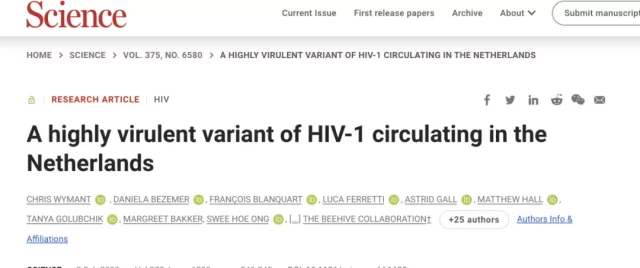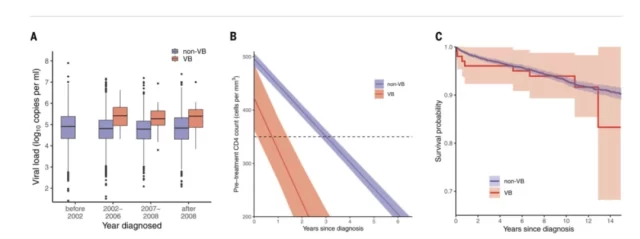The ‘strongest ever’ HIV has been discovered: 109 people infected already
- Normal Liver Cells Found to Promote Cancer Metastasis to the Liver
- Nearly 80% Complete Remission: Breakthrough in ADC Anti-Tumor Treatment
- Vaccination Against Common Diseases May Prevent Dementia!
- New Alzheimer’s Disease (AD) Diagnosis and Staging Criteria
- Breakthrough in Alzheimer’s Disease: New Nasal Spray Halts Cognitive Decline by Targeting Toxic Protein
- Can the Tap Water at the Paris Olympics be Drunk Directly?
The ‘strongest ever’ HIV has been discovered: 109 people infected already
- Should China be held legally responsible for the US’s $18 trillion COVID losses?
- CT Radiation Exposure Linked to Blood Cancer in Children and Adolescents
- FDA has mandated a top-level black box warning for all marketed CAR-T therapies
- Can people with high blood pressure eat peanuts?
- What is the difference between dopamine and dobutamine?
- How long can the patient live after heart stent surgery?
The ‘strongest ever’ HIV has been discovered: 109 people infected already.
Recently, a more virulent and more transmissible new type of HIV has been discovered in Europe, which has infected at least 109 people.
On February 3, the academic journal “Science” published a paper to introduce this new HIV variant. Researchers from the University of Oxford in the UK and the University of Amsterdam in the Netherlands named it the VB mutant, saying that its viral load is the same as that of ordinary HIV infection. 3.5 to 5.5 times the rate of post-infection, CD4 cells decline twice as fast, and in the absence of treatment, the development of intermediate HIV infection occurs about 9 months after infection, compared with about 3 years for ordinary HIV infection.
According to the paper, the VB mutant may have existed for about 30 years, and it was produced by de novo mutation of the virus rather than genetic recombination. There are still a lot of mysteries to be solved in terms of origin, virulence and infectivity.

The virus has been around for 30 years
In a previous study, researchers found 17 HIV-infected people, 15 from the Netherlands, were infected with a new, unknown mutant strain of HIV. After expanding the scope of the study, an additional 92 cases of infection with the novel mutant strain were identified.
Let’s first look at the relevant data on the VB mutant.
In the absence of treatment, CD4 cells decreased to 350 cells/mm³ for about 9 months in VB mutant-infected patients and 36 months in conventional HIV-infected patients. Entering the generally recognized AIDS onset period, the VB mutants are infected for about 2 to 3 years, and the conventional infection is about 6 to 7 years.
To explain the dramatic rise in virulence, the researchers looked for clues through the mutated genomes of VB mutants. Reports indicate that VB mutants carry multiple mutations with significant changes in their genomes affecting nearly 300 amino acids. However, due to the relative dispersion, the genetic cause of increased virulence cannot be determined at present.
In terms of mortality, after treatment, it is similar to that of conventional HIV-infected patients. This is because existing antiretroviral drugs, the standard of care for HIV, have not diminished their effect on the VB mutant. At the same time, this may be one of the reasons why VB mutants have not completely replaced conventional HIV.
Simply put, the virulence of VB mutants and the duration of treatment are mutually constrained. Due to the high virulence of VB mutants, both morbidity and mortality are increased in the absence of treatment. However, because the VB mutant strain is more virulent and has a short incubation period, the symptoms appear faster in patients, which accelerates the timely intervention of medical intervention.

How did the VB mutants arise? The researchers have not yet come to a definite conclusion.
Different from the emergence of drug-resistant bacteria because of the abuse of antibiotics, because the existing AIDS treatment drugs are still sensitive to VB mutants, it is not “survival of the fittest”. The researchers’ preliminary study concluded that it is likely that the original infected person did not receive treatment for a long time, and this mutation was derived.
Through statistical modeling of the data, the researchers found that the VB mutant was likely to have appeared in the Netherlands as early as the 1980s, and the rate of transmission had been faster than other mutants at the beginning of this century, but after 2010, the rate of transmission slowed down significantly.
For similar reasons, the rapid detection and intervention of medical methods also reduces the probability of HIV-infected persons carrying out high-risk transmission behaviors, while the relevant screening and treatment methods have not been fully rolled out before.
“A more deadly variant of the new coronavirus may emerge”
“Is it ‘doing the hard work’, or is it a short-term high-light burning?” Professor Joel Wertheim, an expert on virus evolution at the University of California, San Diego, said in a related editorial that the less virulent HIV, the lower the viral load, the longer the lifespan of the host, but the greater the transmission ability. weak. Conversely, the host will enter the onset phase sooner, with a higher transmissibility, but with a shorter transmission time.
Naturally, viruses generally choose the middle ground. However, medical intervention has made the factors more complicated, and the selective driving factors behind HIV evolutionary trade-offs are still not fully explained.
This time, scientists hope to further clarify the balance between the virus’ virulence-infectivity-treatment. Previous studies have tried to explore the most appropriate timing of HIV treatment. One view is that:
In the case of HIV, without treatment, it is less likely to mutate toward higher virulence because the host develops the disease rapidly, limiting opportunities for transmission. And once the treatment is rolled out too early and too wide, it may accelerate the production of highly virulent HIV.
The simple understanding is, “Anyway, it has to be blocked, it is better to increase the toxicity.”

The variant increased the number of HIV virus particles in the blood of infected people.
Image from Cavallini James/BSIP/Science Photo Library
But VB mutants were created at a time when therapeutic drugs were not widely available. This time the researchers came to a different conclusion: extensive treatment helps prevent new highly virulent variants, because regardless of virulence, treatment will reduce its potential. the process of pre-dissemination.
In other words, if viruses cannot replicate, they cannot mutate.
The researchers also emphasized that because VB mutants are more harmful to the human immune system, early diagnosis and early treatment have become crucial.
In addition, the discussion of this study has further extended to the field of new coronavirus. Scientists believe the finding hints at the risk of more deadly variants of the new coronavirus.
“The emergence of Omicron fuels the claim that the new coronavirus is becoming less deadly, but this is not the evolutionary principle of the new coronavirus.” Professor Emma Hodcroft, a molecular epidemiologist at the University of Bern in Switzerland, said.
Professor Chris Wymant, one of the authors of the paper, said that the discovery of the VB mutant is a warning, “We should not underestimate the potential of virus evolution, and we should not be too confident that the virus will only develop in a milder, less virulent direction. .”
“Since the first case of AIDS was discovered in the United States in 1981, the viral load at the time of diagnosis has increased every decade, both before and after treatment became available.” Professor Joel Wertheim said how the virus will evolve in the future to respond to human disease “Encirclement and suppression” is still unclear.
But he also emphasized that the emergence of more virulent and infectious HIV is not a public health crisis, and existing surveillance, screening and treatment methods can still be effectively dealt with.
references:
1.Highly virulent HIV variant found circulating in Europe,https://www.nature.com/articles/d41586-022-00317-x
2.Who discovered the highly virulent HIV variant? Where was it discovered? https://en.as.com/en/2022/02/07/latest_news/1644273990_298526.html
The ‘strongest ever’ HIV has been discovered: 109 people infected already
(source:internet, reference only)
Disclaimer of medicaltrend.org
Important Note: The information provided is for informational purposes only and should not be considered as medical advice.



